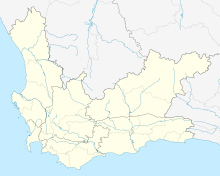Pinnacle Point
| Pinnacle Point | |
|---|---|
| Location | Mossel Bay, Western Cape Province |
| Coordinates | 34°12′28″S 22°05′22″E / 34.20778°S 22.08944°E |
Pinnacle Point a small promontory immediately south of Mossel Bay, a town on the southern coast of South Africa. Excavations since the year 2000 of a series of caves at Pinnacle Point have revealed occupation by Middle Stone Age people between 170,000 and 40,000 years ago. The focus of excavations has been at Cave 13B (PP13B), where the earliest[vague] evidence for the systematic exploitation of marine resources (shellfish) and symbolic behaviour has been documented,[1] and at Pinnacle Point Cave 5–6 (PP5–6), where the oldest[vague] evidence for the heat treatment of rock to make stone tools has been documented.[2] The only human remains have been recovered from younger deposits at PP13B which are c. 100,000 years old.[3]
History of the research

The discoveries at Pinnacle Point have been made by an international team, headed by
After debating for decades, paleoanthropologists now agree there is enough genetic and fossil evidence to suggest that
Pinnacle Point 13B and its implications for modern behaviour
At PP13B, the evidence for symbolic behaviour comes in the form of scraped and ground
Also at PP13B are an anomalous quantity of dicotyledonous tree leaf phytoliths in sediments that are roughly 90,000 years old. Though alteration of phytoliths introduce uncertainty to these findings, the quantity of tree phytoliths relative to grass phytoliths has been suggested to indicate a history of wood burning in hearths.[6]
Provincial heritage site
In December 2012, the provincial heritage resources authority Heritage Western Cape declared Pinnacle Point a provincial heritage site in the terms of Section 27 of the National Heritage Resources Act.[7] This provides the site with the highest form of protection under South African heritage law.
In 2015, the South African government submitted a proposal to add the cave to the list of World Heritage Sites and it has been placed on the UNESCO list of tentative sites as a potential future 'serial nomination' together with Blombos Cave, Sibudu Cave, Klasies River Caves, Border Cave, and Diepkloof Rock Shelter.[8]
See also
- Hominid evolution
References
- ^ S2CID 4387442, retrieved 3 April 2013
- S2CID 43916405
- ^ Marean, Curtis W.; Nilssen, Peter J.; Brown, Kyle S.; Jerardino, Antonieta; Stynder, Deano (2 May 2004), "Paleoanthropological investigations of Middle Stone Age sites at Pinnacle Point, Mossel Bay (South Africa): Archaeology and hominid remains from the 2000 Field Season." (PDF), PaleoAnthropology, 1: 14–83, retrieved 4 April 2013
- S2CID 31169551
- PMID 20934095, retrieved 4 April 2013
- S2CID 129222853– via Wiley Online Library.
- ^ "Provincial Notice 70/2012", Province of the Western Cape Provincial Gazette (7075), Cape Town: 2672, 14 December 2012
- ^ "The Emergence of Modern Humans: The Pleistocene occupation sites of South Africa". UNESCO. Retrieved 3 April 2015.
External links
- Site by Pinnacle Point, at SAHRA

